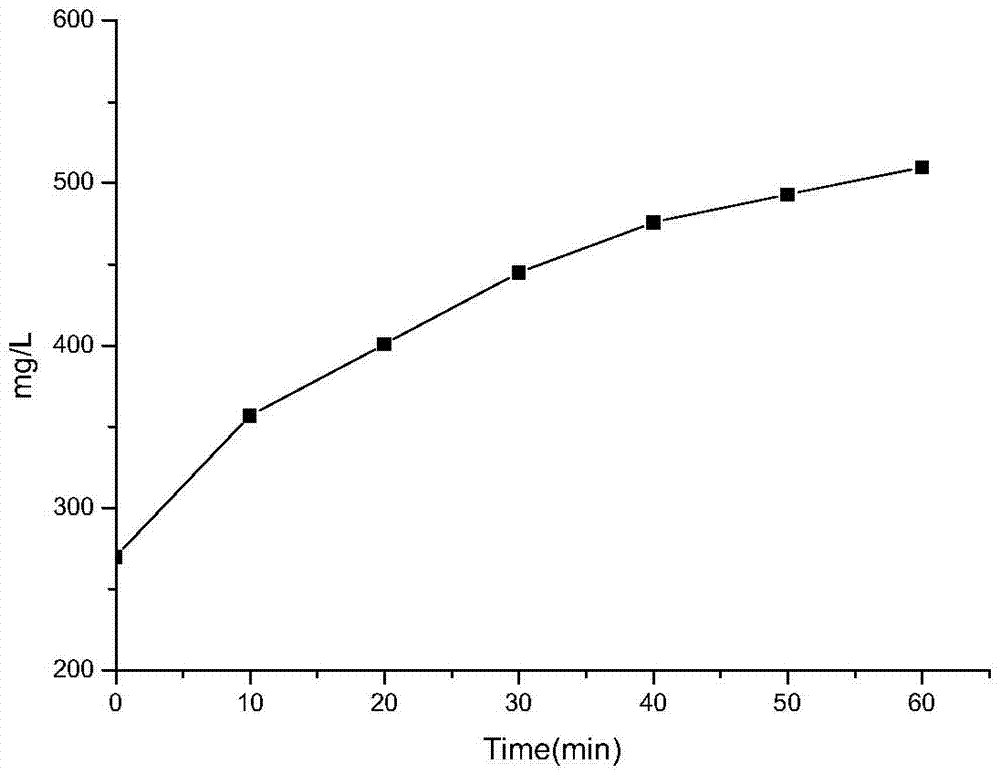Loaded enzyme hydrogel composition with oxygen releasing function and hydrogel prepared from hydrogel composition
A composition and hydrogel technology, applied in the direction of drug combination, organic active ingredients, inorganic active ingredients, etc., to achieve the effect of improving oxygen supply, beneficial to healing, and good biocompatibility
- Summary
- Abstract
- Description
- Claims
- Application Information
AI Technical Summary
Problems solved by technology
Method used
Image
Examples
Embodiment 1
[0035] Add 8g of guar gum to 50mL of deionized water, heat to dissolve, add 1.5g of sodium alginate to dissolve after cooling to room temperature, add 0.04g of glucose oxidase and 0.04g of catalase under stirring conditions, mix well, and form a viscose Thick aqueous solution, that is, component A (containing 800μg / mL glucose oxidase, 800μg / mL catalase, 190g / L hydrocolloid);
[0036] Add 0.8 g of borax to 50 mL of deionized water, dissolve, then add 6 g of glucose under stirring conditions, mix well to form an aqueous solution, which is component B (containing 120 g / L glucose, 16 g / L cross-linking agent);
[0037] Mix components A and B evenly to obtain a hydrogel, and use an oxygen electrode to measure its oxygen sustained release effect. After component A and component B are mixed in a closed flask, the oxygen concentration change is measured by an oxygen concentration measuring instrument, and the measurement results are as follows: figure 1 shown.
Embodiment 2
[0039] Add 0.3 g of polyvinyl alcohol to 50 mL of deionized water, heat to dissolve, add 0.2 g of sodium alginate to dissolve after cooling to room temperature, add 0.1 g of glucose oxidase and 0.1 g of catalase under stirring conditions, mix well, and form Viscous aqueous solution, that is, component A (containing 2000μg / mL glucose oxidase, 2000μg / mL catalase, 10g / L hydrocolloid);
[0040] Add 0.1 g of borax to 50 mL of deionized water, dissolve, then add 0.5 g of glucose and 0.5 g of carbamide peroxide under stirring conditions, and mix well to form an aqueous solution, which is component B (containing 10 g / L glucose, 2 g / L cross-linked agent);
[0041] Mix components A and B evenly to obtain a hydrogel, and use an oxygen electrode to measure its oxygen sustained release effect.
Embodiment 3
[0043] Add 150g of gelatin to 500mL of deionized water, heat to dissolve, add 50g of oxidized starch to dissolve after cooling to room temperature, add 0.005g of glucose oxidase and 0.005g of catalase under stirring conditions, and mix well to form a viscous aqueous solution, namely Component A (containing 10μg / mL glucose oxidase, 10μg / mL catalase, 300g / L hydrocolloid);
[0044] Add 40 g of borax to 500 mL of deionized water, dissolve, then add 200 g of glucose under stirring conditions, and mix well to form an aqueous solution, which is component B (containing 400 g / L glucose and 80 g / L cross-linking agent);
[0045] Mix components A and B evenly to obtain a hydrogel, and use an oxygen electrode to measure its oxygen sustained release effect.
PUM
 Login to View More
Login to View More Abstract
Description
Claims
Application Information
 Login to View More
Login to View More - R&D
- Intellectual Property
- Life Sciences
- Materials
- Tech Scout
- Unparalleled Data Quality
- Higher Quality Content
- 60% Fewer Hallucinations
Browse by: Latest US Patents, China's latest patents, Technical Efficacy Thesaurus, Application Domain, Technology Topic, Popular Technical Reports.
© 2025 PatSnap. All rights reserved.Legal|Privacy policy|Modern Slavery Act Transparency Statement|Sitemap|About US| Contact US: help@patsnap.com


